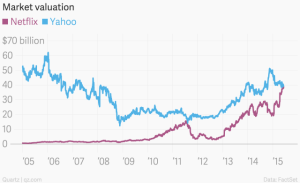GOOD NEWS FOR PANDORA LISTENERS . . . AND ADVERTISERS
Pandora’s sponsored listening program leads to higher ad engagement by *decreasing* the frequency of the ads. We think that advertising which helps users get what they want works much better than advertising that interrupts what they want.
GOOD NEWS FOR INSTAGRAM
The opening of its ad platform could well mean that Instagram will make more from mobile in 2017 than Google or Twitter.
GOOD NEWS FOR HULU
With all the big streaming news coming from Netflix (on which we can’t yet advertise), you might wonder if Hulu (on which we have run many successful ad campaigns) can keep up. Turns out they’re doing very well, thank you: With brand-new content deals for Showtime (including Homeland, The Affair and Masters of Sex) and getting the Hulu remote app up and running on Apple Watch, they’re continuing to stay ahead of a fast-swimming pack.
BAD NEWS FOR BROADCAST TV (lots of it):
Younger demographics are abandoning traditional TV in droves. (via @BenedictEvans)
Also a BI article about the same study.
The change in TV consumption is in its infancy, but it’s far enough along that we can start to see trends in how it’s developing. Here are some of the ways.
More signs of the switch in TV consumption: For the first time, more people are using Comcast for internet than for TV . . .
Or you could pay up to $200k for a thirty second spot on Caitlyn Jenner’s new show.
#video #probablytechnicallygoodnews
BAD NEWS FOR “OLD GAWKER”
It hasn’t been a great time to lead, read, or work at Gawker recently. We trust they’ll turn it around.
BAD NEWS FOR TWITTER
Bad news for Twitter and its advertisers: A June 2015 study suggests only 3% of Twitter users find ads on Twitter relevant. This is fixable, but will take better work on both the creative and targeting sides.
There was some good news in Twitter’s earning’s call on Tuesday, where it announced higher than expecting revenues, but investors were unimpressed with user growth.
THIS THING IS “BAD NEWS” BY DESIGN:
“If a thing is designed to kill you, it is, by definition, bad design”: Mike Monteiro in Dear Design Student.
(via @NextDraft http://nextdraft.com/ )
BAD NEWS FOR BACK-TO-SCHOOL SALES . . .
“Parents are blowing-off back-to-school shopping.” The article blames this on poor mobile advertising, but we think it is simply more a reflection of larger trends: toward flexibility and buying what you need when you need it, and away from the long-term planning style of household management.
. . . OR IS THAT GOOD NEWS?
Google uncovers trends and shares advice about reaching back-to-school shoppers based on search trends. Since search interest for “back to school” rose 48% last year, it’s worth giving them a listen.
GOOD NEWS? BAD NEWS? DEPENDS HOW YOU LOOK AT IT
ClickZ published a useful thought piece about targeting: The more smartphones know about us, the better advertisers (like us) can target ads. Generally, we think this is a positive thing when it’s applied with care and respect for people. But do we want a world where the health tracker on your phone suggests you have indicators of heart disease . . . so you get served an ad for a book on heart disease? Yes and no.












